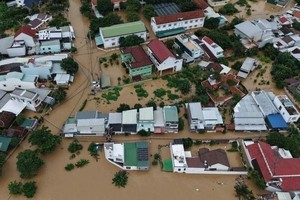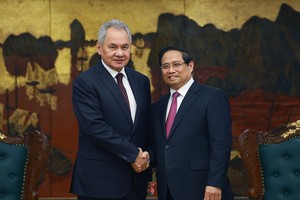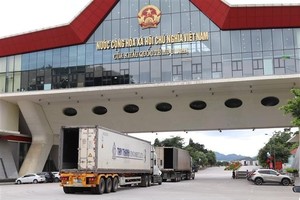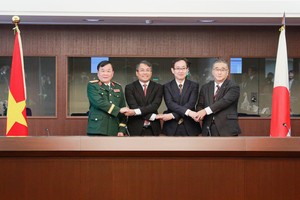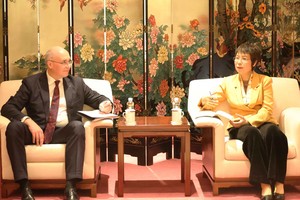KITAKAMI, Japan, March 22, 2011 (AFP) - Engineers battled to get cooling systems at a crippled Japanese nuclear plant back up Tuesday after smoke and steam escaping from stricken reactors delayed the operation.
White steam-like vapour was seen rising from one reactor and what looked like white hazy smoke from another, 11 days after a monster 14-metre (46-foot) tsunami knocked out the plant's cooling systems and backup generators.
The twin quake and tsunami disaster, Japan's worst crisis since World War II, has now left 8,805 people dead and a further 12,664 listed as missing, with entire communities along the country's northeast coast swept away.
But fears of a full-scale nuclear disaster at the Fukushima No. 1 plant, which lies just 250 kilometres (155 miles) from the greater Tokyo area and its 30 million inhabitants, have in many ways overshadowed the natural disaster.
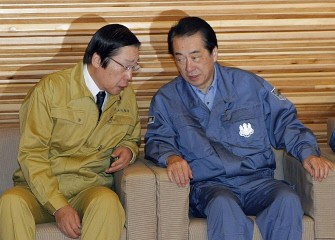
Plant staff and technicians, firefighters and military personnel were struggling to prevent a full meltdown at the seaside plant but spikes in radiation levels have at times forced the crews to suspend work.
Higher than normal levels of radiation have been detected in some farm produce from regions around the plant, as well as in sea water and tap water in Tokyo, forcing authorities to suspend shipments of milk and some vegetables.
Prime Minister Naoto Kan's office moved to reassure consumers Tuesday that no seafood from Fukushima prefecture had entered the market since the quake.
The government has urged people to keep calm, with chief spokesman Yukio Edano insisting that radiation levels, although elevated, do not pose an immediate risk to human health.
"Even if you eat and drink them (contaminated products) several times it will not be a health hazard. So I would like you to act calmly," Edano said.
The only exception was tap water in a single village near the troubled plant, whose inhabitants were advised not to drink the water as a precaution.
The government has declared an exclusion zone with a radius of 20 kilometres around the plant and evacuated tens of thousands while telling people within 20 to 30 kilometres to stay indoors.
The Japanese head of the UN atomic watchdog, Yukiya Amano, said he had "no doubt" the nuclear crisis would be "effectively overcome" -- while cautioning that the situation remained serious.
France's Nuclear Safety Authority, however, warned that local contamination from the plant would last "for decades and decades".
The six-reactor plant has been hit by a series of blasts since the March 11 tsunami, and radiation levels around the facility have hit danger level, in the worst nuclear crisis since the Chernobyl disaster in the Soviet Union in 1986.
Concerns have focused on reactor number three, which contains potentially more dangerous plutonium, and on reactor four, where reduced water levels at a storage tank containing used fuel rods had led to overheating.
While external power has been restored to all six reactors, it was unclear whether engineers would be able to get cooling systems back online at reactors one to four. Cooling systems at reactors five and six were already running.
Workers were forced to evacuate part of the plant on Monday when grey smoke rose from reactor number three, operator Tokyo Electric Power Co. said.
TEPCO staff have reconnected the plant to the power grid and hoped to reconnect cooling systems soon, but it was unclear how much damage these sustained during the series of explosions at the facility.
Firefighters were ready to again use high-pressure water jets to keep overheating under control on Tuesday and stop fuel rods from degrading and releasing high levels of radiation.
A truck with a pump 50 metres high was also expected to start pouring water into the storage tank -- the so-called containment pool -- of reactor four.
Prime Minister Kan said Monday there was "slow but steady progress" in dealing with the atomic crisis.
"Workers' efforts at the risk of their lives have made the situation progress little by little," he said, according to a government spokesman.
The latest bid to get cooling systems working came as TEPCO said the size of the wave that knocked out power was larger than originally thought and at least 14 metres high, judging by what a spokesman called "traces of the tsunami".
Rain that on Monday complicated rescue efforts and compounded the misery of tsunami survivors had eased on Tuesday, but for the nearly half a million people huddled in chilly shelters, conditions were grim.
"We are really short of water and food. We don't have enough toilets either," said Tsutomu Nakai, a businessman in charge of relief efforts for about 1,000 people sleeping at a school in the town of Rikuzentakata.
Authorities have struggled to cope with the scale of the humanitarian crisis, with hopes of finding more survivors dim, despite the discovery Sunday of an 80-year-old woman and her grandson still alive in their collapsed house.
It was not just the human cost of the catastrophe that defied imagination. The twin natural disaster -- Japan's deadliest since 1923 -- could cost the world's third-biggest economy up to $235 billion, the World Bank said.
That would be equivalent to 4.0 percent of annual economic output, in an economy that has already been struggling for years.
But growth should pick up in subsequent quarters "as reconstruction efforts, which could last five years, accelerate", the bank said in a report.
Tokyo's stockmarket, which took a pummelling most of last week, jumped four percent as the Bank of Japan renewed its emergency fund provision injecting two trillion yen ($24.67 billion) into the money market to calm jittery investors.
It has now injected a total of 39 trillion yen to soothe markets and ease concerns about the ability of financial institutions to meet demand for funds.
